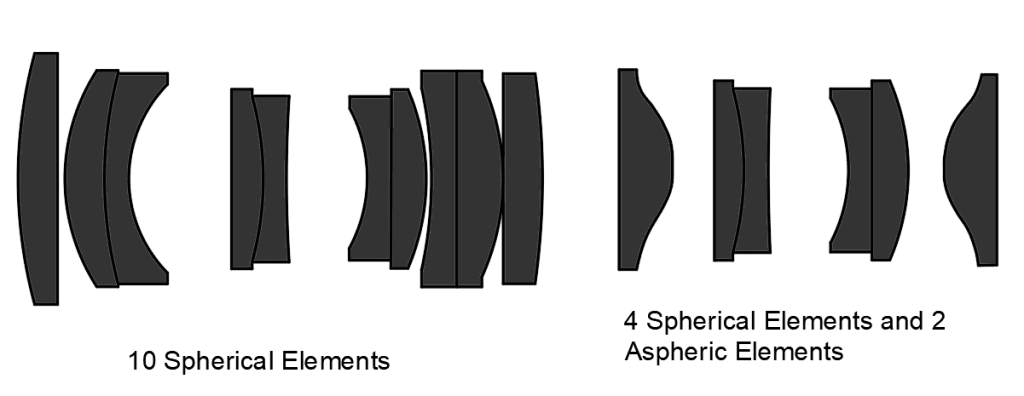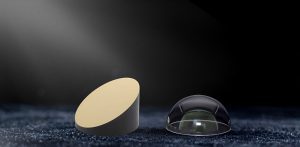Key Takeaways
- Aspheric lenses possess a variable radius of curvature, allowing for a gradual change in shape that corrects optical aberrations effectively.
- Recent advancements in grinding and polishing techniques, particularly for subaperture polishing, have significantly lowered the cost of high-quality aspheric lenses, making them economically viable to replace multiple spherical lens elements.
- Aspheric lenses provide superior aberration control, enabling optical designers to use fewer elements, simplifying assembly and reducing system size and weight.
Aspheric lens (ASP lens) elements and spherical lens elements differ in their surface shapes. Spherical lenses have a consistent curvature across their entire surface, resembling a portion of a sphere. Conversely, aspheric lenses possess at least one aspheric lens element, featuring a variable radius of curvature across the lens surface, in contrast to the constant curvature of spherical lenses. Both types find applications in microscopy systems, laser systems, cameras, telescopes, and other various optical devices.
Aspheric lenses exhibit a gradual curvature change from the center to the periphery, allowing for a more intricate shape that effectively corrects optical aberrations. These lenses are instrumental in minimizing aberrations like spherical aberration, coma, astigmatism, and distortion in optical systems. Such aberrations can result in issues such as large focused spot sizes, image distortion, and reduced image resolution. Optimizing the coefficients and radius of curvature of aspheric lenses helps design systems that eliminate these aberrations, enhancing optical performance with sharper images and diffraction-limited resolution. The incorporation of aspheric lenses is a prevalent strategy in modern optical design to achieve superior performance in a more compact form.
Avantier specializes in designing and producing aspheric lenses for diverse optical systems, including cameras, microscopes, telescopes, medical devices, and laser scanners.
For decades, aspheric lenses have played a crucial role in reducing spherical aberration and in enhancing optical system performance. However, their high cost has limited their widespread application. Recent advancements in aspheric grinding and polishing techniques, particularly subaperture polishing, have facilitated the production of high-quality aspheres without the need for magneto-rheological finishing (MRF), which significantly reduces costs. A single affordable, high-performance aspheric lens can now replace multiple spherical lenses, achieving similar or superior performance. This advancement results in lighter, smaller, and more cost-effective optical systems.
Benefits of Aspherical Lenses
Aspheric lenses are designed to reduce aberrations, especially spherical aberration. Spherical aberration is a distortion that occurs when light passes through a spherical surface, causing blurriness and reduced image quality. Aspheric lenses focus light to a single point, regardless of the entry angle, resulting in clearer and sharper vision. Aspheric lenses can be particularly useful in compact optical systems where minimizing size and weight is crucial. Some of the key benefits of using an aspherical lens in an optical application are:
- Compact design
- Smaller number of lens elements required in an optical assembly
- Reduced lens aberrations such as spherical aberration, distortion, and astigmatism
- Sharper focusing
- Larger lens aperture size
- Improved optical performance
- Improved light collection efficiency
Reducing Lens Elements
One notable advantage of aspheric lenses is their superior aberration control, which allows optical designers to use fewer elements compared to designs that employ conventional spherical optics. This reduction in the number of elements simplifies the assembly process, decreases system size and weight, and minimizes the surfaces where internal reflections can occur, thereby increasing light throughput.

Reducing Cost
While a single aspheric lens may traditionally be more expensive than a spherical lens, recent manufacturing advancements have substantially lowered the cost of high-performing aspheres. Advanced subaperture aspheric grinding and polishing techniques now approach the irregularity capabilities of spherical full-aperture grinding and polishing. This new development enables the production of high-quality aspheres at a reduced cost, making it economically viable to replace multiple spherical lens elements with fewer aspheric lenses. Although magnetorheological finishing (MRF) may still be required for extremely high-quality aspheres, it is no longer a necessity for all manufacturing processes, further contributing to cost reduction and increasing the adoption of aspheres in optical designs.
For custom requests, visit Aspheric Lens. Please contact Avantier if you’d like to schedule a consultation or request for a quote on your next project.
GREAT ARTICLE!
Share this article to gain insights from your connections!




